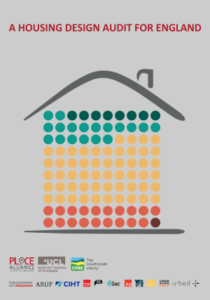 The IHBC has welcomed a new audit on new housing design in England, noting conclusions about overwhelmingly ‘mediocre’ or ‘poor’ standards, and how less-affluent communities remain the worst affected, but highlighting the potential for conservation professionals to help improve.
The IHBC has welcomed a new audit on new housing design in England, noting conclusions about overwhelmingly ‘mediocre’ or ‘poor’ standards, and how less-affluent communities remain the worst affected, but highlighting the potential for conservation professionals to help improve.
IHBC vice chair Lone le Vay, who represented the IHBC at the launch, said: ‘ We do welcome the report, for highlighting many of the problems with recent housing developments. In that context especially, we would like to highlight the potential of our conservation professional members to help the planning system to address these issues.’
‘Our members’ skills in understanding, defining and explaining local character and architecture are, in my view, essential to informing the design of new residential d
evelopments, and ensuring that they are locally distinctive, legible, accessible, liveable and sustainable.’
Place Alliance writes:
A housing design audit for England reveals that 75% of new housing development should not have gone ahead due to ‘mediocre’ or ‘poor’ design.
The report, an audit of over 140 housing developments built across England since 2007, found that one in five of these developments should have been refused planning permission outright as their poor design was contrary to advice given in the National Planning Policy Framework. A further 54% should not have been granted permission without significant improvements to their design having been made first.
The audit also found that:
- Less affluent communities are ten times more likely to get worse design, even though better design is affordable;
- Low-scoring housing developments scored especially badly in terms of character and sense of place, with architecture that does not respond to the context in which it is located;
- The worst reported aspects of design include developments dominated by access roads and the poor integration of storage, bins and car parking, leading to unattractive and unfriendly environments with likely negative health and social implications;
- Some gains have been made – schemes scored relatively highly for safety and security and were also typically successful at integrating a variety of sizes of house;
Professor Matthew Carmona (The Bartlett School of Planning, UCL) Chair of the Place Alliance, who led the research, said: ‘Research has consistently shown that high quality design makes new residential developments more acceptable to local communities and delivers huge social, economic and environmental value to all, yet we are still failing in this regard across England.
‘Planning authorities are under pressure to deliver new homes and are therefore prioritising numbers in the short-term over the long-term negative impacts of bad design. At the same time, house builders have little incentive to improve when their designs continue to pass through the planning system. Some highways authorities, meanwhile, do not even recognise their role in creating a sense of place for communities.
‘Collectively, house builders, planning authorities and highways authorities need to significantly raise their game. This can’t come soon enough’…
Recommendations from the research
The audit proposed a range of recommendations for the Government, house builders and local government. Amongst these the research found strong benefits in designing at higher densities than is the norm. The Government should be more prescriptive in seeking less sprawling densities, as more compact developments tend to be designed more sensitively. It should require highways design that helps to create high quality,
characterful places.
Housebuilders need to drive greater ambition across the sector in order to advance a more ethical approach to the design of development that prioritises the long-term social wellbeing of their customers and the health of the environment at large.
Local authorities need to use proactive design codes – design parameters established for each site – and design review processes for all major housing schemes. Local authorities also need to end the current disconnect between highways design and planning aspirations when it comes to new housing areas.
Schemes which do not meet minimum requirements should be refused on design grounds and this should be supported, without question, by the Government regardless of progress towards meeting housing targets in the area.
The full report – A Housing Design Audit for England – including a regional breakdown of the results and recommendations for action can be found here

